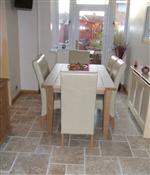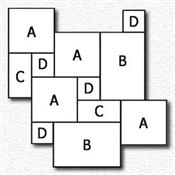Opus Romano
Tile and Thick Paver Designs Available in the Opus Romano, French Versailles,
Roman Romano, and Rome Opus Patterns
We will use the name “Opus Romano” in our description and marketing material to help prevent name pattern confusion.
The Opus Romano tile mold pattern is a classic tile pattern used throughout the ages to achieve the desired layout shown in the photos and illustrations on this page. The actual sizes can vary, but are always relative to each other in the size percentages as illustrated. The illustrations and photos here start with our 8″x8″ tiles, and progress from there.
We have come across three different patterns that seem to be considered Opus Romano Patterns. Two are square, recurring patterns that are made up with either three or four different tile sizes. The three sizes we have illustrated are in our Wind Swept Tile molds and are 8″x8″, 8″x16″, and 16″x16″. The four-tile pattern also includes a 16″x24″ Wind Swept tile mold, with all molds being 3/4″ deep.
There is what many consider the “true” Opus Romano tile pattern that includes four different sizes, and while recurring, the design also fits or interlocks inside itself— like a puzzle. This makes the pattern transitions indistinguishable as to where the pattern starts and where it finishes. The pattern flows as random tiles inter-woven within itself. Some people refer to this pattern as a French Versailles floor pattern, Roman Romano, Rome Opus, and other similar names. The pattern sizes are normally made by starting with either 6″x6″ or 8″x8″ tiles. The “six inch pattern” then proceeds to 6″x12′, 12″x12″ and then 12″x18″. The “8 inch pattern” proceeds from 8″x8″ to 8″x16″, 16″x16″, then 16″x24″. The 8″ base set is illustrated below in a stained and antiqued Terra Cotta base color.
This tile and stone pattern has always been popular in Europe and throughout the Mediterranean where Travertine, marble, or granite have been mostly used for flooring and walls. Recently though, there have been other materials used to make these shapes and sizes for the Opus Romano pattern. Most notably are concrete tiles and cement pavers that are becoming very popular both for their unlimited color possibilities, as well as their cost savings, range of applications, and availability. And now Olde World Stone offers instructions to turn just about any concrete product made into a Travertine finish through a simple technique on the Training and Instructions website.
Thus, we at Olde World Stone & Tile Molds, Inc. have created two new “products” in the Opus Romano pattern. One is a slip resistant tile with the face texture of a rough sea or field of wheat. We named the style “Wind Swept”. It is illustrated in the photos below.
The second product was actually the result of a customer’s custom order request. They desired an extra thick, smooth, Driveway Paver that would handle the weight of an RV (recreational vehicle) load. They wanted it in a 6″ Opus Romano format pattern. So we created a 3″ thick Driveway Paver for them in the four 6″ sizes needed to make the Opus Romano Pattern. (6″x6″, 6″x12″,12″x12″, and 12″x18″)
One of the many benefits we offer our customers is our ability to design and make new molds, so they can make their own stone products with our molds. And the molds do not have to be poured “full” unless that is the thickness desired. Thus, the 3″ thick Driveway Paver Mold can be poured as thin as 1/2″ thick if a “tile” were needed. Or they can be poured to 1-1/2″ thick if a Patio Paver were needed. And all of those sizes can come from the same mold.
Both of these styles of the Opus Romano Pattern have vertical sides and fairly sharp corners and edges, unlike most concrete tiles that have pillow or rounded edges. This allows installation with very minimal grout lines, and they may even be installed without grout between the tiles on walls or floors to allow a more uniform appearance. The thick Pavers have a slightly more rounded edge and wider space between them than the tile. But as is evident in the “Wind Swept” wall tile photos below, there are no grout lines showing.
Showing 1–10 of 17 results
-

Set #P4006-OR – 12 Driveway Paver Molds – 6″ Set w/Free Shipping
$199.95 Add to cart -

Set #P5006-OR – 12 Alt. Driveway Paver Molds – 6″ Set w/Free Shipping
$199.95 Add to cart -

Set #P1036-OR Set – 3 Driveway Paver Molds – 6″ Set w/Free Shipping
$49.95 Add to cart -

Set #P1046-OR – 4 Driveway Paver Molds – 6″ Set w/Free Shipping
$79.95 Add to cart -

Set #P3006-OR – 13 Driveway Paver Molds – 6″ Set w/Free Shipping
$169.95 Add to cart -

#P12183-05 – 4+1 FREE Thick 12x18x3 Driveway Paver Molds +F/S
$99.99 Add to cart -

#P12183-13 – 10+3 FREE Thick 12x18x3 Driveway Paver Molds +F/S
$249.90 Add to cart -

#P12183-02 – Two Thick 12x18x3 Driveway Paver Molds
$49.99 Add to cart -

#P12123-06 – 6 Thick 12x12x3 Driveway Paver Molds + Free Shipping
$113.99 Add to cart -

#P12123-18 – 15+3 Free 12x12x3 Driveway Paver Molds + Free Shipping
$284.99 Add to cart